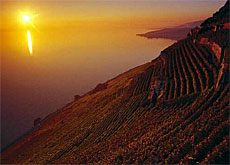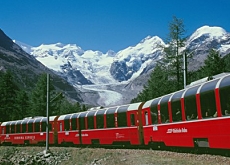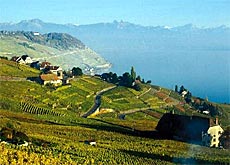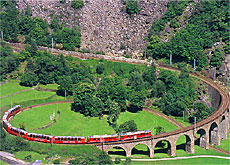Lavaux stakes claim for heritage status

The Lavaux wine-growing area on Lake Geneva has formally submitted its application to become a Unesco World Heritage site.
The government has also asked Unesco for the heritage status granted in 2001 to the Jungfrau-Aletsch-Bietschorn region to be extended over a further 284 square kilometres.
On Wednesday the director of the Federal Culture Office, Jean-Frédéric Jauslin, and representatives of the local association behind the Lavaux bid handed in their application at Unesco headquarters in Paris.
A decision from the United Nations cultural agency is not expected until the summer of 2007, but those behind the project say they are quietly confident that they have a winning package.
“The application is very strong and well put together, but we cannot predict what the decision of the World Heritage Committee will be. However, Lavaux is a really special site and that’s why we are quite positive,” Oliver Martin, spokesman for the Culture Office, told swissinfo.
The picturesque region, which lies between Lausanne and Vevey, is counting on its vineyards, lakeside setting and alpine panorama to enable it to join the other six Swiss sites already on the World Heritage list.
Those that have made the grade include the Old Town in Bern (1983), the Convent of St Gallen (1983) and the castles of Bellinzona (2000).
Inspection team
The Lavaux application will be scrutinised by Unesco officials to check that everything is in order before an inspection team from the International Council on Monuments and Sites is dispatched to the region early next summer.
Their report will then be submitted to the World Heritage Committee, which is made up of 21 countries.
“We are very optimistic, but the examination of our dossier by Unesco is far from a formality,” Philippe Biéler, a member of Lavaux’s bid team, cautioned last week.
“We have to prove that Lavaux… offers unique characteristics.”
There has been concern that the region’s chances could be hampered by the high number of European sites already on the heritage list – something that Unesco is keen to correct.
But Martin said the candidature had been carefully pitched to meet the world body’s new objectives for entry.
“We have tried to fulfil these by choosing a cultural landscape and not offering a single monument like a cathedral, because that would be much more difficult,” he said.
“Here we have an under-represented category – a cultural landscape. The strong point is that Lavaux lies in a zone under pressure from construction and it’s very important to preserve this landscape.”
Planning regulations
The Culture Office said the granting of World Heritage status would not affect existing planning regulations covering Lavaux.
But it pointed out that the region was already protected by legislation at local, cantonal and federal levels. The citizens of canton Vaud even voted in November to cement the preservation of Lavaux in the constitution.
Swiss environmentalist and animal rights activist Franz Weber told swissinfo that a Unesco listing would mark another important step in securing the region’s future.
Weber launched a campaign 30 years ago to protect Lavaux from developers, which culminated in a successful vote in 1977.
“It was the first time anywhere in the world that the people were able to place a landscape under protection,” he said.
“All the political parties were opposed, as well as the government, but the people were with me, and we won.”
swissinfo, Adam Beaumont with agencies
Lavaux was one of five candidates chosen by the government in December last year for recognition by Unesco.
The other four are: the Albula and Bernina railway lines in southeastern Switzerland, the watchmaking towns of La Chaux-de-Fonds and Le Locle, the buildings of Swiss architect Le Corbusier, and prehistoric sites inhabited by ancient lake-dwellers.
The Federal Culture Office plans to submit the application for the Albula and Bernina line in 2007. The bid by La Chaux-de-Fonds and Le Locle is scheduled for the following year.
The six Swiss sites on the World Heritage list:
Old Town of the capital, Bern
Convent of St Gallen
Castles of Bellinzona
Monastery of Mustair
Aletsch glacier region
Monte San Giorgio

In compliance with the JTI standards
More: SWI swissinfo.ch certified by the Journalism Trust Initiative



You can find an overview of ongoing debates with our journalists here. Please join us!
If you want to start a conversation about a topic raised in this article or want to report factual errors, email us at english@swissinfo.ch.